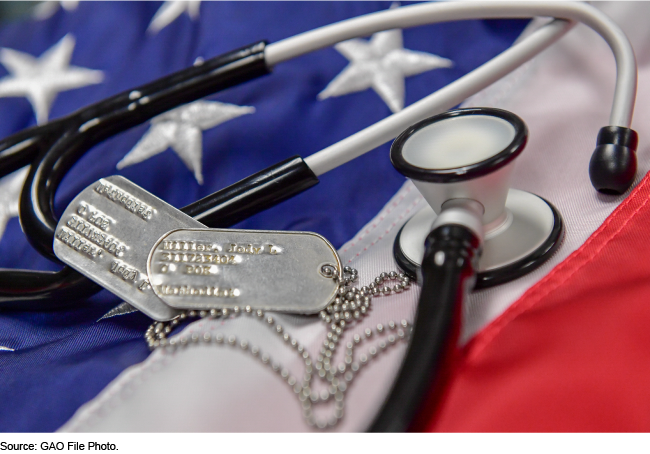VA Research: Opportunities Exist to Strengthen Partnerships and Guide Decision-Making with Nonprofits and Academic Affiliates
Fast Facts
Research at Veterans Affairs medical centers can be funded by VA, or "extramurally" by other federal agencies and non-federal sources. In FY 2019, about half of VA's $1.1 billion in total reported research spending was funded extramurally.
VA partners with nonprofit research corporations and academic institutions to administer funds for most extramural projects. While these partners administer the funds, VA oversees the projects, the investigators who do the research, and the VA resources used.
Our recommendations include developing tools to help the VA select partners that will provide the best support for this research.

Highlights
What GAO Found
The Department of Veterans Affairs' (VA) extramural research spending totaled about $510 million in fiscal year 2019—nearly half of the $1.1 billion in total spending on VA research. Of the $510 million, federal sources, such as National Institutes of Health, funded $382 million (75 percent), and nonfederal sources, including private entities, academic institutions, state and local governments, and foundations, funded $128 million (25 percent). Spending at the 92 VA medical centers that conducted extramural research in fiscal year 2019 ranged from less than $2 million to more than $10 million (see figure). VA medical centers' nonprofit research and education corporations (NPC) and academic affiliate partners administered the grants that accounted for 91 percent of the spending.
Figure: Extramural Research Spending by VA Medical Centers that Conducted Extramural Research in Fiscal Year 2019

VA has made efforts to promote and support VA medical centers' partnerships with academic affiliates—for example, by coordinating a mentoring program for local VA research officials—and considers effective affiliations as an enhancement to research. However, VA's Central Office officials have not provided examples of successful practices for strengthening research partnerships with academic affiliates. Having such practices would promote collaborative opportunities for VA medical centers with academic affiliates, particularly for medical centers that have poor communication with affiliates. Additionally, VA's Central Office has provided general guidance but not specific tools to VA medical centers for determining when an NPC or an academic affiliate should administer a project's extramural funds. Having specific decision-making tools could help medical centers make more informed decisions to provide optimal support for the research.
Why GAO Did This Study
VA research, which has contributed to many medical advances, may be funded by VA's appropriation or extramurally by other federal agencies and nonfederal sources. To access extramural funding, investigators at VA medical centers usually work with an NPC or academic affiliate partner to submit a grant proposal. Once a grant is awarded, medical centers' partners administer the grant by distributing funding, fulfilling reporting requirements, and performing other administrative activities.
GAO was asked to review VA's extramural research. This report examines, among other objectives, (1) how much VA spent on extramural research in fiscal year 2019 and (2) the efforts VA has made to support medical centers' partnerships for extramural research.
GAO analyzed VA policies, documents, and data. It also conducted site visits and interviewed officials from VA's Central Office and from a nongeneralizable sample of VA medical centers, NPCs, and academic affiliates, which GAO selected to represent variation in geographic location and funding.
Recommendations
GAO recommends that VA (1) provide more information to VA medical centers on strengthening research relationships with academic affiliates and (2) develop decision tools to help VA medical centers determine whether NPCs or academic affiliates should administer extramural grants. VA agreed with GAO's recommendations.
Recommendations for Executive Action
| Agency Affected | Recommendation | Status |
|---|---|---|
| Department of Veterans Affairs | The Under Secretary for Health should ensure VA's key offices, such as OAA and ORD, provide VA medical centers with examples of successful practices for strengthening research relationships with academic affiliates and that such information reflects the lessons learned from VA medical centers that have successfully cultivated these relationships. (Recommendation 1) |
Closed – Implemented
VA addressed this recommendation in August 2023 by posting a white paper to the VA's Office of Research and Development website with information on strengthening relationships among VA medical centers, NPCs, and academic affiliates. To identify successful practices for strengthening these relationships, a subcommittee of the VA's National Research Advisory Council conducted stakeholder focus groups with representatives of VA medical centers, NPCs, and academic affiliates. The white paper identified successful practices in three areas: ensuring understanding of the overall academic partnership, communication mechanisms, and written agreements.
|
| Department of Veterans Affairs | The Under Secretary for Health should ensure ORD, in consultation with the field, develops tools, such as a decision tree and successful practices, to help local VA medical center officials decide which entity—NPCs or academic affiliates—should administer extramural funding based on providing optimal support for the research. (Recommendation 2) |
Closed – Implemented
VA addressed this recommendation in August 2023 by posting a decision matrix for administering extramural research awards to the VA's Office of Research and Development website. To inform the decision matrix, a subcommittee of the VA's National Research Advisory Council conducted stakeholder focus groups with representatives of VA medical centers, NPCs, and academic affiliates. The decision matrix suggests that NPCs and academic affiliates can use the rule that an award is administered at the institution where most work occurs but that final decisions may differ depending on real-time constraints and considerations.
|
